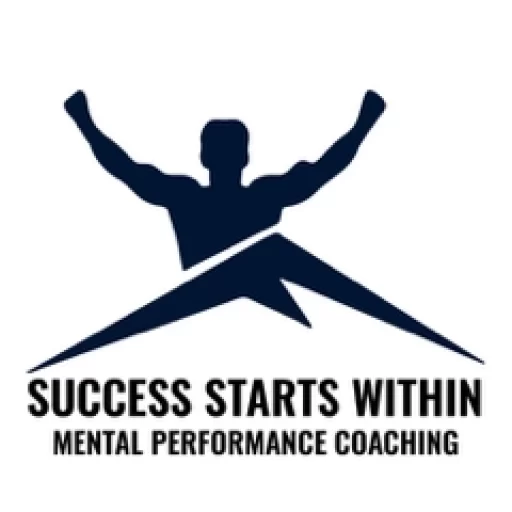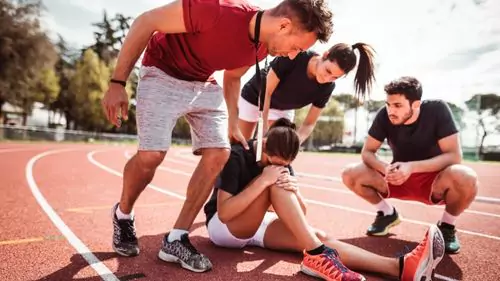Injuries suck, there’s not two ways about that. I doubt there is a single athlete who would rather be sidelined with an injury than competing on the field.
On top of the fact you aren’t getting to play, being injured can have serious implications on an athlete’s mental health. Seeing all the work you’ve put in seemingly go to waste with each game that passes while you watch from a distance eats at your psyche.
There’s also the anxiety which grows out of the fear your future plans in your sport are being undermined by your injury. Depending on the severity of your injury, you may be looking at weeks, months, or even a whole year away from your sport.
To throw one more complication into the mix, it can be very difficult to remain confident in your skills while injured. And once you return from your injury, regaining the confidence to perform as you once did may be difficult.
With all that being said, the title of this article may seem like a confusing dream to you. How can an injury, something that keeps you away from your sport and brings rise to many mental game challenges actually be an opportunity to improve?
I know it seems strange, but trust me, with the tools and techniques I’m about to uncover, you can return from your injury a completely different athlete. With your performances moving forward being all the more better as a result.
Taking A Different Approach To Being Injured
In sports, as in life, there are always multiple ways to view a situation.
Right now, if you’re injured, how are you viewing the situation? Are you feeling sorry for yourself, getting down in the dumps because you can’t play, and feel like your limited time to participate in your sport is quickly expiring?
Look, I get it. That’s the easiest mindset to adopt. But is that actually helping you?
The harsh reality is, you cannot change the fact the injury occured. You are injured, frustratingly sidelined, and must wait until you’re fully recovered to return to play.
Now what?
Once you accept this truth, once you acknowledge your own inability to change what happened, what’s left for you to do?
Well, there’s only one thing left, and that’s to begin taking steps forward.
I’m sure you’re already doing what you need to on the physical side. Whether that be resting right now or physical therapy to restrengthen the injured area.
But to only think about the physical side of your game while injured keeps you from reaping the full benefits this opportunity has to offer.
Decide You WILL Return Stronger!
It all comes down to a simple decision on your part to return from your injury a stronger athlete. Now I’m not talking about being stronger physically, but stronger mentally.
Being sidelined with an injury provides you with a fantastic opportunity to really focus on mental training.
All the practices and games you watch, along with the freed up time where you normally would be putting in additional physical training grants you with tons of space to train your mind.
While you may not be able to actually swing a bat, shoot a ball, or run, all of those can be simulated in your head.
On top of that, I’m sure there are aspects to your game you feel less confident in. What about pressure, are there moments during a competition where you succumb to the pressure you feel?
All of this can be improved through the application of mental rehearsal, also known as visualization.
By utilizing mental imagery while injured, you can be sure you will return from your injury a stronger player. You may even be grateful for the opportunity the injury awarded!
How Mental Imagery Works
Mental imagery, mental rehearsal, and visualization are all terms used to describe the same process. This process involves you going over a scene in your mind, either with your eyes open or closed.
Think about daydreaming. How many times have you been in class or a situation that wasn’t too exciting and you found your mind drifting off into some fantasy you created?
That is visualization at work!
Only, we can use this technique in a deliberate and meaningful way to improve your athletic performance. But why is this? How can imagining something actually have an effect on your physical performance?
It all has to do with the way your brain responds to the imagery work.
When you imagine something, your mind does not simply see this as an image. Through studies, it has been found that your brain fires in the same way during a visualization session as it does when the action is actually being performed.
So let’s say you visualize yourself shooting a basketball. Your brain will fire small impulses to your arms, legs, and all the muscles involved in taking that shot.
What this means is, you are creating the muscle memory in your mind of shooting a basketball. On top of that, you can utilize emotions to feel successful after each shot you make.
So now, not only are you improving the actual skill of shooting a basketball, but by seeing yourself do it successfully you are also instilling confidence within yourself.
This is why visualization is so powerful, and how through the process of mental rehearsal you can elevate your game, even while injured.
Now it’s time to show you how to do so! Let’s dive right into the different mental imagery techniques you can begin to use while sidelined with an injury.
“When you imagine something, your mind does not simply see this as an image. Through studies, it has been found that your brain fires in the same way during a visualization session as it does when the action is actually being performed.”
Mental Imagery Techniques To Perform While Injured
There are two forms of mental imagery, one performed in a very structured manner, with your eyes closed, and another that’s more like daydreaming with your eyes open.
For these techniques, I am going to be focusing on the first one. The reason being, this allows you to take the visualization seriously and reap the full rewards of the practice.
Once you get good at rehearsing with your eyes closed, you can begin going over the scene in your mind while on the sideline during practice or a game.
Alright, so the beginning of the mental imagery work will look the same for each technique. One of the best ways to ensure your visualization is clear and powerful is by first calming your mind.
That is why each of these techniques will begin as follows:
- Find a quiet location where you will be free from distractions. It can often be difficult to visualize clearly, so the last thing you want is to have a bunch of distracting noises happening around you.
- Close your eyes.
- Now begin taking slow deep breaths, in and out through your nose. Make it rhythmic and try to only focus on the sensation of your breath. Do this for a few minutes and you will be ready to bring the scene into your mind.
Mental Imagery For Skill Mastery
The first technique I want to introduce is visualizing for skill mastery. Here I want you to think about all the different aspects of your game. When trying to decide what to visualize, ask yourself the following questions:
- What do I typically do in practice?
- What are the moves and plays I make during a game?
- What are some weaknesses in my game right now?
- What are the drills I typically do on my own to train?
When you’re visualizing for skill mastery, think of it like a shortened practice or simulated game.
You are wanting to go over in your mind all the aspects of your game, especially the areas you need the most improvement.
Here are some examples you can use for a few different sports:
Baseball Player (Pitcher)
You want to simulate a game, seeing yourself throw to batters. Face lefties, righties, power hitters, and contact hitters. See yourself throwing all your different pitches, hitting different spots.
This is a time for you to place yourself into different counts and situations (though we will cover that more in detail in a coming technique).
Baseball Player (Hitter/Fielder)
You want to see yourself taking at bats. Put yourself in different situations and counts. Visualize the pitcher throwing you different pitches to multiple locations. Most importantly, see yourself squaring up the ball and standing on base!
In the field, go over any drills you normally do. Take reps of ground balls, fly balls, and see yourself making all throws on target.
Soccer Player
As a soccer player, think about your position on the field.
Are you a striker, the goalie, a midfielder, or defender? Based on your role, think about the specific situations you find yourself in during a game and go over them in your mind.
You can also get more targeted with your mental imagery and visualize yourself performing dribbling drills and so on.
Basketball Player
Go over different shots on the court. If you’re a midrange shooter, spend the majority of your time going over the shots you typically take, but also spend time taking threes and making post moves.
Same thing goes if you’re a three point shooter or a forward. Also go over free throws, and see yourself playing defense.
Just as with the other’s you can break it down and simulate specific drills you perform in practice as well.
Football Player
Depending on your position, pick out the main jobs you have during a game and simulate them.
If you’re a quarterback, see yourself calling plays, making passes on the money, and reading defenses. As a receiver see yourself run routes, catch passes, and avoid defenders. Same goes for running backs.
On defense, go over coverages in your mind, track defenders, and make plays.
I know these are only a few of the many sports that can use visualization to gain skill mastery, and if your sport was left off, look to these others as inspiration.
To make the most of mental rehearsal to gain mastery in your skills, you want to be sure you’re getting specific, breaking down your play, and seeing yourself succeed.
Those basic principles remain constant no matter your sport.
“To make the most of mental rehearsal to gain mastery in your skills, you want to be sure you’re getting specific, breaking down your play, and seeing yourself succeed.”
Mental Imagery To Gain Confidence
When you’re wanting to be more confident, the mental imagery work will be centered more around a feeling within a situation than simply the scene.
Confidence is a feeling, and what you need to begin doing with your visualization is associating that feeling of confidence with the situations in which you wish to be more confident.
Bring whatever scene into your mind where you would like more confidence. Go through the visualization, seeing yourself successfully performing in vivid detail.
Now, here’s the most important part. You have to get to the end of the scene and feel confident.
You see, confidence is formed through experience, seeing ourselves succeed within a skill over and over. So, by getting to the end and feeling confidence, you are instilling that memory within your mind.
Mental Imagery To Perform Well Under Pressure
Do you want to be a clutch player?
Of course you do, everyone wants to be thought of as someone who can perform well, even under the most stressful of circumstances.
But to do so takes practice. When you’re injured, you have a tremendous opportunity to rehearse these pressure moments in the safety of your mind.
Think about a time during a game when you feel the most pressure.
During your visualization, go there! Put yourself in that moment. Feel the nerves, feel the anxiety and tension that accompany it. Don’t shy away from these feelings, because you are wanting to make the scene as real as possible.
Now, once you’ve made it real, replace those feelings of nervousness with how you want to feel. Do you want to feel confident, calm, motivated, amped up? How would you like to feel, and most importantly, what feeling would lead to you succeeding?
Once you’re in that new emotional state, see yourself performing with ease, succeeding at the end and once again relishing in that success.
Final Thoughts
These three techniques are fantastic ways to elevate your game while injured. If you utilize imagery work, you no longer have to watch as your level of play decreases throughout the recovery process.
You can be actively gaining skill mastery, improving confidence, and developing the ability to perform under pressure.
One important point I would like to make is try not to perform all these visualizations at once. Yes, you can do them all each day (and I encourage you to do so), but do them at separate times.
Mental rehearsal shouldn’t take longer than ten minutes at a time. But, you want to ensure you’re giving full attention to each of these techniques so that they have the optimal impact they can on your performance.
If right now you’re injured, I know it’s tough, but accept the injury and now get to work, using mental imagery to make the most out of the situation you’re in.
I hope you enjoyed this article and if you did please share it with others.
If you have any questions, please do not hesitate to reach out to me.
Thank you for reading and I wish you the best of success in all that you do.




